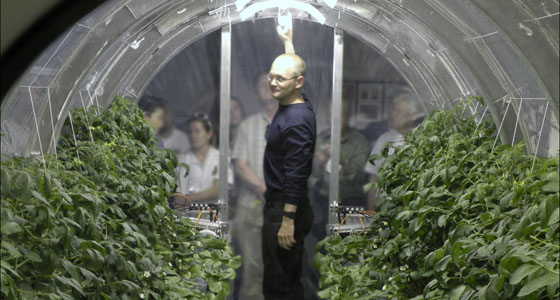Prototype Lunar Greenhouse (LGH)
Ground Control Research Tool

- Full Name: Prototype Lunar Greenhouse (LGH)
- Affiliation: NASA, University of Arizona
- Country: United States
- Focus Areas: Bioregenerative Life Support System
- Type: Ground Control
Summary
In the early 2000s, a team at the University of Arizona designed the Prototype Lunar Greenhouse to feed astronauts, freshen the air, and recycle water and nutrient wastes in space. This greenhouse is inflatable and collapsible, equipped with a hydroponics system and grow lights. The walls are transparent to allow sunlight to shine on the plants. The LGH is surprisingly easy to build because it deploys autonomously, meaning it is deployed and constructed by computers instead of astronauts.
Since 2004, Phil Sadler, Robert Furfaro, and Gene Giacomelli have worked on the LGH with 30-40 dedicated students, faculty, staff, and international collaborators.

Though it is unclear whether this lunar greenhouse will ever be deployed in space, we have learned a lot from it. In 2015, scientists tested multi-cropping systems in this greenhouse. Multi-cropping is the practice of growing two or more crops in the same growing space. Multi-cropping can improve yields in traditional agriculture, but it has never been tested in space—meaning data from these multi-cropping experiments may inform our future space gardening decisions. Alongside the role of the LGH as a space greenhouse, its other purpose is to provide a practical commercial-ready controlled environment greenhouse for use on Earth. Even if the LGH is never used on the Moon or Mars, it is still a valuable research tool for understanding how we can grow plants on Earth and beyond.
The LGH as a Bioregenerative Life Support System:
This greenhouse is a Bioregenerative Life Support System (BLSS) because it recycles waste products (namely CO2 and nutrient waste) and provides food. BLS systems provide five main services: 1) atmosphere revitalization, 2) water recycling, 3) food production, 4) organic waste recycling, and 5) power generation. Dr. Gene Giacomelli says, “We’re mimicking what the plants would have if they were on earth, and using these processes for life support. The entire system of the Lunar Greenhouse does represent, in a small way, the biological systems that are here on Earth”.

References
- Prototype Lunar Greenhouse Website
- Full Scale Lunar Greenhouse Prototype (video)
- Prototype BLSS Lunar Greenhouse
- NASA designs inflatable greenhouse for sustainable farming on Mars
- UA researchers build lunar greenhouse prototype
- The Mars-Lunar Greenhouse (M-LGH) Prototype for Bio Regenerative Life Support: Current Status and Future Efforts
